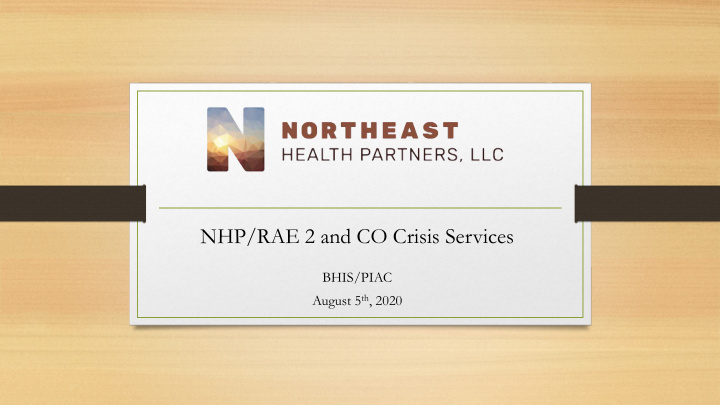



NHP/RAE 2 and CO Crisis Services BHIS/PIAC August 5 th , 2020
How are you evaluating success when it comes to care coordination? No specific measure for success has been formally identified . Our TOP success is ensuring the member • receives the level of care that was necessary in the crisis and any identified follow up. Additional areas to help the programs be successful: Increased understanding of roles, duties, expectations of each entity; across systems and regions • Increased partnerships and collaborations with all players/providers at the same table without any restrictions (remove • barriers, align HCPF and OBH goals) RAE and CCS receive real time data/similar data • Mapping workflows between RAE & CCS • RAE CMHC stakeholders and CCS in R2 are the same entities (North Range/Centennial MHC) • RAE and ASO CCS staff are both employed by Beacon, supporting ease of communication between the two groups • Protocols in place for care coordination with MHC’s •
How does RAE CM approach differ with a member who has received CCS? • Not everyone who receives CCS is known to the RAE CC • The CCS provider follows a protocol of 1, 2 & 5 day follow up with members who are not admitted to higher level of care • At the time of discharge, Beacon connects with the CMHC and Care Coordinator to ensure discharge planning/continuity and follow-up • Opportunity for improvement: Increase bidirectional info sharing •
What is working well when coordinating care between the two systems? Have best practices been developed? • RAE behavioral health and CCS providers are the same entities in R2 North Range Behavioral Health & Centennial Mental Health Center • Partners are the same and known to each other—easy to reach out and connect • • RAE Care Coordinators and CMHCs participate in ongoing discussions regarding Complex and High-Risk Members. Workflows identified/established regarding shared members •
What are future needs to help improve CC between the two systems? What are the gaps and barriers? • Real-Time Data Sharing Individual member level • Community provider utilization data • • Joint meetings • Ensuring no duplication of work • Seek out provider feedback on: What is working well? • What are the gaps? •
Specific transition of care strategies for members being discharged: ATU/CSU/Residential • Beacon Clinical Care Manager (CCM) has ongoing collaboration with ATU/CSU/Residential facilities to improve care transitions, implement person- centered planning at discharge, and address complex Member needs. • Beacon CCMs shares the discharge information with both the CMHC and the RAE care coordinator to ensure appropriate follow up care. • RAE Care Coordinators partner with both of the CMHC’s in the region to support integrated care efforts that includes expedited communication to avoid duplication of services. This communication in turn permits for a close working relationship and sharing of information/resources about specific Members who need higher levels of care and/or need coordination as they transition to lower levels of care.
How can RAEs coordinate efforts with CCS mobile response team? • Talk to providers Inquire how they think things are working • Level setting about functions of RAE and CCS • • All parts of the system need real time access to assessment results, referral information, etc. • Increased education between both entities and community on RAE and CCS • Workflows that directly include RAE CC and CCS
General Network Analysis: Are CCS providers contracted as a RAE provider? Any gaps in the network? • Yes, CCS providers are contracted as RAE providers North Range & Centennial • • Gaps—higher LOC systems not always readily available such as: Diversion to respite • Local adolescent CSU/in-patient •
What does collaboration with the CCS ASOs look like? • What is working well? • CC process • Great relationships with community providers/open dialogue for continued improvement efforts. • Crisis services kept in same EHR as the clinical/out-pt system Easier to plug members into services • Not needing an ROI removes barriers • • What is needed for the future? • Real time data and alignment between HCPF and OBH on goals, vision & metrics
What performance metrics have the greatest opportunity for improvement based on work with CCS? • Difficult to align performance metrics due to: Lack of ability to share or access real time data • • Data being requested from HCPF and OBH differ Different performance metrics required from HCPF and OBH • Providers/Prescribers can change dx within 120 days • • Would suggest we look at: 7 and 30 day follow up BH appointments • How can we reduce ED utilization when there are minimal to no field medical clearance • possibilities Co-branding •
What specific strategies can be implemented with the help of CCS to impact performance measures? • Alignment of performance measures (as able to) • Real time data, automated info sharing • Review of ED utilization and readmission • Monthly to quarterly meetings with RAE medical and BH providers and CCS
Recommend
More recommend